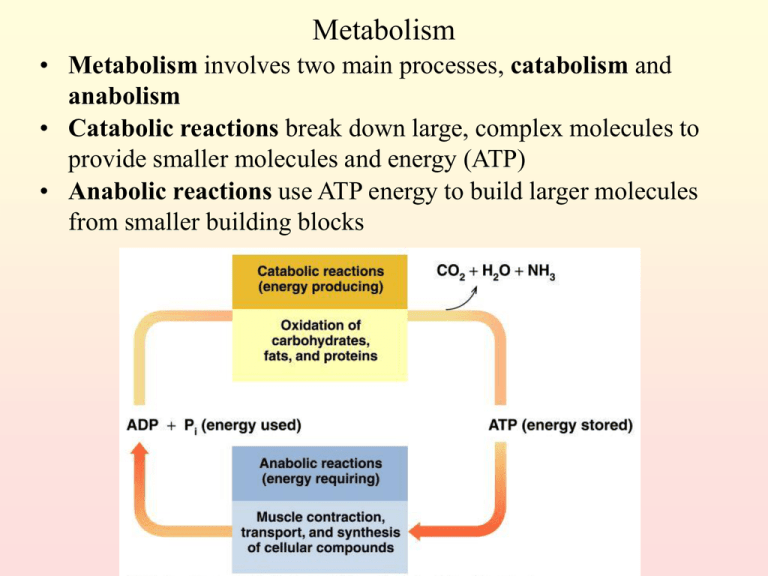Metabolism
advertisement

Metabolism • Metabolism involves two main processes, catabolism and anabolism • Catabolic reactions break down large, complex molecules to provide smaller molecules and energy (ATP) • Anabolic reactions use ATP energy to build larger molecules from smaller building blocks Stages of Catabolism Catabolic reactions are organized into three stages: • In Stage 1, digestion breaks down large molecules into smaller ones that enter the bloodstream • In Stage 2, molecules enter the cells and are broken down into two- and three-carbon compounds • In Stage 3, compounds are oxidized in the citric acid cycle to provide energy (ATP) for anabolic processes Stages of Catabolism (Diagram) Eukaryotic Cell Structure • Metabolic reactions occur at specific sites within the cell Components of Eukaryotic Cells ATP and Energy • In cells, energy is stored in adenosine triphosphate (ATP) - there are other cellular energy sources, but ATP is the main one Hydrolysis of ATP • The hydrolysis of ATP to ADP releases 7.3 kcal (31 kJ/mole) ATP ADP + Pi + 7.3 kcal (31 kJ/mole) • The hydrolysis of ADP to AMP releases 7.3 kcal (31 kJ/mole) ADP AMP + Pi + 7.3 kcal (31 kJ/mole) ATP and Muscle Contraction • Muscle fibers contains filaments of actin and myosin • When a nerve impulse increases [Ca2+], the filaments slide closer together to contract the muscle • The hydrolysis of ATP in muscle provides the energy for contraction • As Ca2+ and ATP decrease, the filaments return to the relaxed position Coenzyme NAD+ • When a compound is oxidized by an enzyme, 2H as 2H+ and 2eare removed by a coenzyme, which is reduced • NAD+ (nicotinamide adenine dinucleotide) participates in reactions that produce a carbon-oxygen double bond (C=O) • For example, NAD+ participates in the oxidation of ethanol: Overall Reaction: + OH O Alcohol dehydrogenase NAD + + H Oxidation: O + OH 2H + + 2e - H Reduction: NAD+ + 2H + + 2e - NADH + H + NADH + H + Structure of Coenzyme NAD+ • NAD+ (nicotinamide adenine dinucleotide) contains ADP, ribose, and nicotinamide (from niacin, B3) • NAD+ reduces to NADH when the nicotinamide group accepts H+ and 2e- Coenzyme FAD • FAD participates in reactions that produce a carbon-carbon double bond (C=C) Oxidation —CH2—CH2— —CH=CH— + 2H+ Reduction FAD + 2H+ + 2e- FADH2 + 2e- Structure of Coenzyme FAD • FAD (flavin adenine dinucleotide) contains ADP and riboflavin (vitamin B2) • FAD reduces to FADH2 when flavin accepts 2H+ and 2e- Coenzyme A (CoA) • CoA activates acyl groups, such as the two-carbon acetyl group for transfer to other compounds • It consists of pantothenic acid (vitamin B5), phosphorylated ADP and an aminoethanethiol Digestion of Carbohydrates (Stage 1) • In the mouth, salivary amylase hydrolyzes -glycosidic bonds in polysaccharides to give smaller polysaccharides (dextrins), maltose, and some glucose • In the small intestine, pancreatic amylase hydrolyzes dextrins to maltose and glucose • The disaccharides maltose, lactose, and sucrose are hydrolyzed to monosaccharides in the small intestine • The monosaccharides enter the bloodstream - fructose and galactose are transported to the liver, where they are isomerized to glucose - glucose is transported to cells for metabolism Overview of Stage 1 of Carbohydrate Catabolism Glycolysis (Stage 2) • In Stage 2 of carbohydrate catabolism, the metabolic pathway called glycolysis degrades glucose (6C) obtained from digestion to pyruvate (3C) • Glycolysis is an anaerobic process that takes place in the cytoplasm Energy-Investing Phase of Glycolysis In reactions 1-5 of glycolysis: • Energy is used to add phosphate groups to glucose and fructose • Glucose is converted to two three-carbon molecules Energy-Producing Phase of Glycolysis • In reactions 6-10, the hydrolysis of phosphates generates four ATP molecules • Two NAD+ coenzymes are also reduced Glycolysis, Overall Reaction • Glycolysis generates 2 ATP and 2 NADH • Two ATP are used in energy-investment to add phosphate groups to glucose and fructose-6-phosphate • Four ATP are formed in energy-generation by direct transfers of phosphate groups to four ADP Overall Reaction: Glucose + 2ADP + 2Pi + 2NAD+ 2Pyruvate + 2ATP + 2NADH + 4H+ Regulation of Glycolysis • The amount of glucose that goes through glycolysis is regulated based on relative levels of ATP, ADP and AMP, as well as other glycolysis intermediates • This regulation takes place at three steps: - Reaction 1: Hexokinase is inhibited by high levels of glucose-6-phosphate, which prevents the phosphorylation of glucose - Reaction 3: Phosphofructokinase, an allosteric enzyme, is inhibited by high levels of ATP and activated by high levels of ADP and AMP - Reaction 10: Pyruvate kinase, another allosteric enzyme is inhibited by high levels of ATP or acetyl CoA
